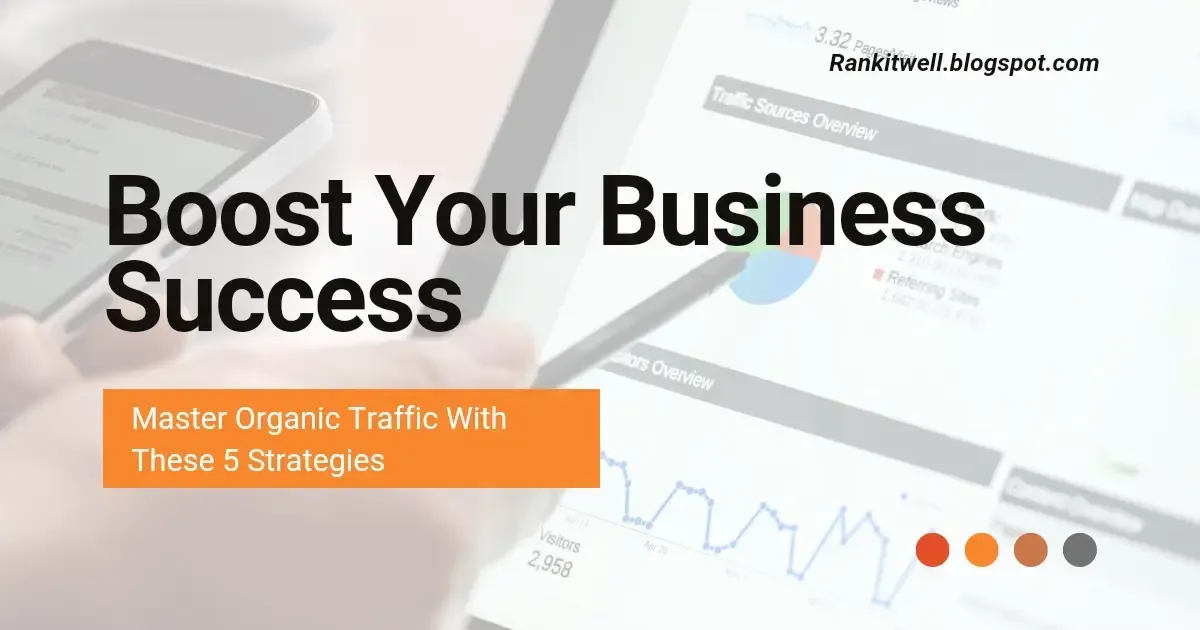What Is Organic Traffic In Marketing ?
You probably found this article because you must have heard how important organic traffic is for digital marketing and increasing sales on a permanent basis.
If no one has ever told you such a thing, allow me to be the first to show you the benefits of this type of traffic capable of exponential growth on the Internet!
Starting with the Cost Per Click (CPC) on Google Ads, which is expected to see a historic increase of 5% in 2023, with other search engines and social networks following in the same direction.
To make matters worse, this increase in the cost of Paid Media is expected to lead to a 20% increase in the Customer Acquisition Cost (CAC) in 2023.
The higher the CAC, the more expensive your product or service needs to be for the end consumer, and that kind of pressure doesn't usually make anyone happy.
My name is Sourav, I'm the admin here at Rank It Well, and the ambition of the platforms that run ads doesn't surprise me because they aim to make as much profit as you and I do.
What bothers me is that, even though it has become increasingly expensive for companies (like yours) to close new deals, their investments in digital marketing have been falling since 2022.
I decided to write this article as a way to contribute to the survival (and success) of your brand in these difficult times, sharing what I learned about organic traffic in my life.
As Paid Media prices will only increase over the next few months, you need to start dominating the first search engine results today!
To get there, we'll start with the basics.
What Is Organic Traffic?
In the language of Digital Marketing, organic traffic is the flow of people that arrives at your business naturally, without you having to invest in Paid Media/Ads.
This flow is fundamental to the health of your company in the medium and long term because, unlike other types of traffic, organic traffic is cumulative!
While direct traffic (when someone types your website address into their browser), referral traffic (when another website leads to yours), and social traffic (originating on social media) are short-lived or punctual, organic traffic is lifelong.
As the generation of organic traffic is based on the creation of quality content through Content Marketing, published material receives more and more visits as time passes.
With more visits, search engines like Google attribute more authority to your website, elevating such content to the top positions in search results.
With exposure that only increases over the years, the investment in generating the content itself is paid only once, but the profits from it can grow for decades!
It is for this reason that a Digital Marketing strategy, with a focus on organic traffic, can significantly reduce CAC, even in the face of rising Paid Media prices.
Now that you know what organic traffic is, I’m going to answer the new question that must have popped into your head...
How To Sell (And Grow) Organically?
Organic traffic has a snowball effect because it takes advantage of the concept on which Digital Marketing was built: familiarizing potential customers with your brand!
"Branding" is the act of making your company easily recognizable to the types of customers with the greatest potential to buy from it.
Authority and branding go hand in hand because the more someone comes across your brand in moments of doubt (especially when they are searching for answers on search engines or social media), the more willing they will be to buy from you!
This is because authority is built on familiarity fed by branding — which, in turn, is nourished by the publication of content optimized to be found on the Internet through SEO techniques (I'll talk more about this in a moment).
When a company is unknown to its ideal audience (especially when it does not invest in Digital Marketing), approaching a potential customer becomes an unwanted and invasive act: in addition to losing an opportunity to sell, the brand loses the customer to the competition!
The opposite is also true: with branding generating familiarity by making your business appear when the public needs it most, customers feel lucky to come across you.
From this familiarization, there is the possibility of cultivating a relationship with potential customers, making them feel honored to receive your attention — since you provided so much to them without asking for anything in return!
This is why organic traffic is powerful: the impression you give your audience is that you have Customer Success as a priority and that only your company has the practical knowledge or tools to make it successful!
I will present three ways to achieve this result, but they all revolve around publishing content capable of transforming the audience's lives for the better!
With Content Marketing
What is content marketing?
Content Marketing is what we call the strategic planning of texts, videos, e-books, audios, and graphics, aiming to educate your ideal audience around the problems they face or the desires they have.
When you meet people's needs through content, you have the opportunity to shape how they think because you gain authority points and an emotional space in their hearts!
It's a natural human reaction: we trust those who make us feel good — and this maxim applies to companies too.
The more topics relevant to your ideal audience you cover with valuable content, the more your brand will be present in these people's purchasing journeys.
As they ask search engines things they would never say to someone in the real world, you have the opportunity to create a strong connection — becoming the only solution they trust!
Knowing that, by clarifying your potential customers' doubts, you can also shape the way they think, you cannot leave this responsibility in the hands of the competition!
When generating organic traffic using Content Marketing strategies, you need to:
• Know well the type of audience you want to affect (which will influence which questions you will invest resources in offering answers).
• And reaffirm the criteria that the customer will use to evaluate a decision when it is time to close the deal, the attributes or experiences that only your company has!
The soul of organic traffic lies in the creation of spectacular content — and it's no surprise that "information" is the greatest weapon of the 21st century.
With SEO (Search Engine Optimization),
Creating magnificent content is not everything; you need to make sure it is found by those who will buy the ideas, services, or products that your company offers!
We do this by applying SEO techniques to Content Marketing.
What is SEO? It does exactly what the name suggests: increases the chances of your content being found in the first results of Internet searches!
It's creating valuable materials and ensuring they are found by those who matter, which organically attracts new potential customers. If you're a beginner and want to know more about SEO, you can read this.
Some of the common SEO practices involve:
Know the personality and needs of the ideal audience, to assess which questions they are looking for answers to.
• Use possible keywords that these people use in such searches in the title, subtitles, and body of the content.
• And aim for the best possible experience for the user, both when accessing the website where the content is posted, as well as the clarity of the material and its real usefulness for those who need answers.
• Keep in mind that although algorithms are computer codes, they are exceptional at separating truly valuable content from content that is full of keywords but doesn't help anyone.
It's no use just looking like your business wants Customer Success: you need to create materials without copying anyone, taking great care in the information, and also in the ease of navigation of the website where it is located, to deserve the first position in the search results.
With Email Marketing,
E-mail Marketing is the strategy of communicating with customers and selling in an automated but personalized way — one-on-one.
Unlike publications on websites, which are made available to thousands of people at the same time and in which people themselves search for answers, an email is a communication:
• Intimate
• Highly personalized
It is frighteningly effective when initiated by the company based on a previous relationship (created by branding and the generation of authority).
Along with Content Marketing and SEO, Email Marketing makes up a methodology within Digital Marketing called Inbound Marketing, which brings together the most effective strategies for increasing sales!
You've certainly seen examples of Email Marketing in real life, and they are used to:
• Welcome new customers
• Bring valuable and exclusive content to visitors who subscribe to an exclusive list
• Create a sense of community and undivided attention between the brand and potential customers
• And even to incite desire for (and sell) new services or products to people who have previously purchased from your brand.
As this type of communication is customizable and "hot" (that is, maintained based on pre-established familiarity), the possibilities for using Email Marketing are endless!
Just keep the following in mind: don't send your potential customers the types of messages they wouldn't want to receive.
Otherwise, it's just success!
How To Create An Effective Organic Traffic Strategy
To extract the best from organic traffic, it is necessary to plan the budget for this Digital Marketing strategy without it weighing down short and medium-term goals.
The results from this type of traffic are incredible, but they don't happen overnight: it takes time, investment, and patience.
Once the organic traffic strategy is in action, it can continue generating results even when there is a budget cut (in the case of a crisis).
This versatility is opposite to Paid Media(Ads), in which, when cutting advertising budgets, the entry of new customers (and new sales) stops immediately!
In my experience with clients of all sizes here at Rank It Well, keeping around 20% of the total budget for Content Marketing is enough to take advantage of everything organic traffic has to offer.
It is important that this 20% is separate from the 80% directed towards your company's immediate objectives, and that its injection into organic traffic is not felt by your business.
The saying that "slow and steady wins the race" is valid in this case: it is better to constantly invest a little bit than to invest nothing at all.
Investing too much, but without partnering with an Inbound Marketing agency that knows how to use a larger budget to accelerate the performance of organic traffic, can also backfire.
Before talking about this acceleration, I need to list some concepts that you can never ignore if you want to increase organic traffic.
Check them out!
1. Highlight organic traffic in planning.
Before investing time or money in creating rich content capable of attracting your ideal audience through SEO, it is essential to know which are the best channels to put together the type of strategy that will work for your business!
When planning any other goals for your company, I recommend that you and your team set aside some time to discuss:
• Where your ideal customers go on the Internet.
• What inquiries are they trying to find solutions for?
• What questions about your products or services can be answered and used in this strategy.
You might read that planning your organic traffic strategy based on search volume is a good idea, but after more than two decades of working in Digital Marketing, I say that this tip is outdated!
What really brings quality organic traffic is leaving numbers aside during planning and focusing on one thing: the personality of your potential customers.
2. Understand your persona very well.
The personality of your ideal customer is what we call "persona" in Digital Marketing — an outline:
• How your consumer acts.
• What does he need.
• What problems he faces.
And details such as where he lives, his gender and age, and other characteristics that come out of the generalized field of the "target audience" in order to reach individuals within his audience.
Knowing personas helps your company create a narrative about how your audience will behave when presented with content A or content B.
When done well, this narrative can directly relate to the stages of the purchasing journey that your potential customers will go through before deciding to do business with you!
Knowing who they are, where they go, and how you can fascinate them with the best your brand has to offer, your company will know not only how to attract them but how to convince them!
Even with this understanding, organic traffic can benefit your business because, once you create content that attracts new consumers, you get to know them a little better, making your future Paid Media campaigns more assertive, effective, and economical.
There is no doubt: organic traffic really has all the pomp that I mentioned at the beginning of this article!
3. Create attractive materials
By understanding the personality of your ideal consumers (something you can do by looking at the social networks of the customers who spend the most money with your business), you will be able to develop relevant content for them!
The more interesting materials you generate, the more chances your business will have of being found on social media and search engines, potentially reducing the CAC I mentioned earlier.
Remember to always add a Call To Action (also known as CTA) to direct your future customers to similar content or to a landing page that captures information from them in exchange for exclusive material (such as an e-book or webinar).
This way you ensure that they spend as much time as possible on your website (which does wonders for the positioning of your content at the top of search results) and also convert curious visitors into leads (potential customers).
4. Optimize the content you already have
I need to emphasize that creating content from scratch is important, but keeping the materials you have already published updated is essential!
You do this by applying Digital Marketing techniques and optimizing content to meet the requirements of great SEO.
Fixing grammatical errors, cleaning up the page layout, and checking references to ensure your visitors always receive the most recent data are some ways to do this!
5. Monitor frequently
To know which content to update with more or less priority, you will need to keep an eye on your business metrics.
Metrics are numbers that indicate how people behave on your website:
• How many visitors access each page?
• Which content causes the most engagement?
• Which pages have the highest bounce rates?
It's no use just looking at the numbers — you need to interpret them, since context is everything!
Could it be that the bounce rate is high because of outdated content or because the page takes too long to load?
Could it be that the engagement rate is low because the content is not relevant to the audience or because a CTA is needed to keep visitors on the site once they finish reading an article?
Questions like these are easier to answer with the help of a marketing professional, since this is a multidisciplinary methodology that involves technical numbers together with an understanding of human psychology.
But just by walking around your website as a user (clicking link by link, page by page), you will get a sense of what needs to be done to improve your visitors' experience and get your site to the top positions on Google!
It's no use just creating and publishing content — you need to keep an eye on it to understand how the public will react to it over time.
Planning an organic traffic strategy is less about huge investments and more about continuity.
If you want to reap the benefits of organic traffic as quickly as possible, you can use Paid Media to accelerate the momentum that would take months if left in the hands of search engine algorithms.
After investing in creating relevant content, you can publish it on social networks and search engines such as Google, to attract visits that will signal to robots that your content deserves priority!
Just remember that, for this boost to work, you need to create invaluable materials that:
1. Gather your technical knowledge.
2. Be unique, breaking away from the commonplace that competitors insist on copying from each other.
3. And that synchronize with the qualities and practical experiences that only your company has!
This originality is capable of pulling the rug out from under the competition and dominating the top positions in search results!











